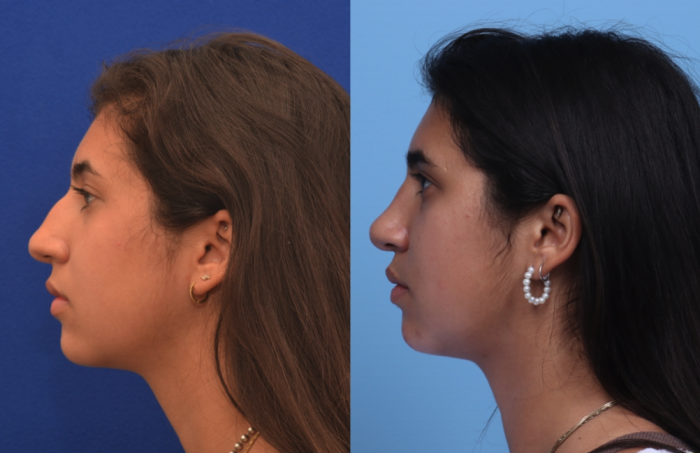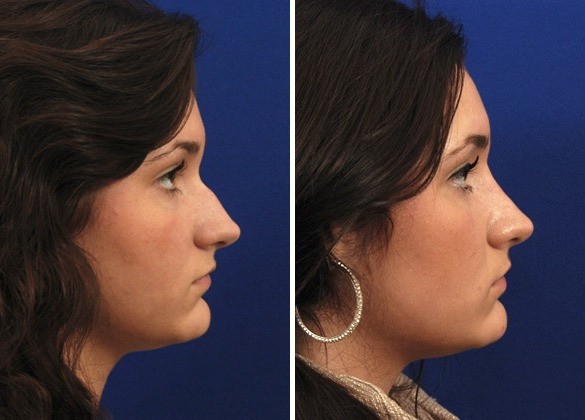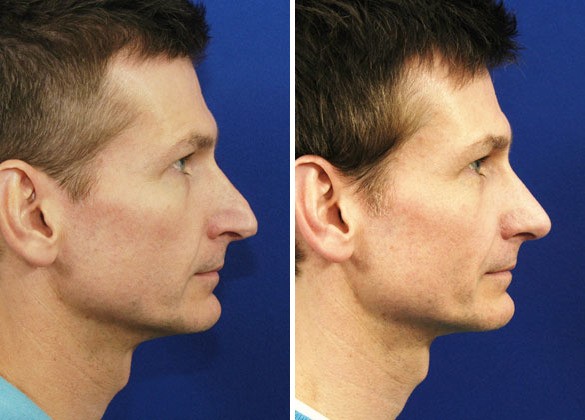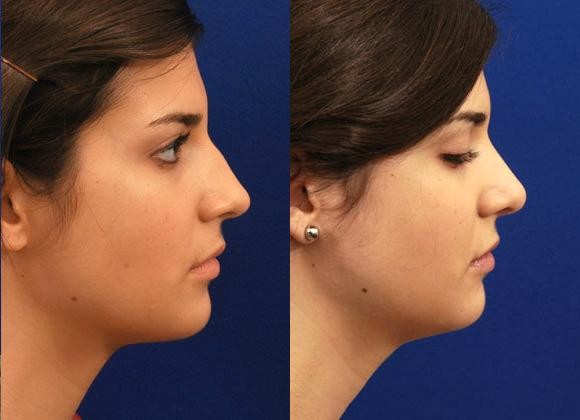
Not everyone is happy with the appearance of their nose and can feel self-conscious in social situations because of this. For those unhappy with the size and shape of their nose or its functionality, rhinoplasty can be the ideal solution. Rhinoplasty, commonly known as a nose job, is a nose surgery that is extremely versatile, helping patients reach subtle or dramatic results depending on their goals. At Hilger Face Center, our surgeons offer solutions for patients such as rhinoplasty and revision rhinoplasty in the Minneapolis and Edina areas.

WHAT IS RHINOPLASTY?
Rhinoplasty is a nose surgery procedure intended to improve the nose's aesthetic appearance or correct functionality issues such as impaired breathing. Common cosmetic issues include a crooked nose, drooping nasal tip, irregular nostril shape, or a deviated septum.
Each rhinoplasty procedure is completely customized to the patient’s needs. Depending on the goals of the nose surgery, patients can see subtle or dramatic differences that not only balance out the face and improve facial aesthetics but also often boost the patient’s confidence and self-esteem dramatically. Partly due to this customization, the surgery itself is extremely complex, requiring the skill and artistic vision of a trained facial plastic surgeon to yield consistently good results. Both functional and cosmetic rhinoplasty can be life-changing for the right patients.
Because each nose is unique, patients have a wide range of concerns that rhinoplasty can help address. Some patients feel their nose is overly large, requiring a reduction rhinoplasty or too small, requiring the opposite: augmentation rhinoplasty. Others have a prominent bump or hump on the bridge of the nose or some degree of crookedness. These types of issues can be genetic, or they can be the result of trauma and injury.
While a large number of rhinoplasty procedures are performed for cosmetic reasons, others are intended to correct breathing problems from a deviated septum or other issues. Some of these functional rhinoplasty patients elect to have cosmetic changes made to the nose at the same time.

WHAT IS REVISION RHINOPLASTY?
In an ideal world, every rhinoplasty procedure would meet or exceed patient expectations. Unfortunately, that is not always the case. No matter what the reason, some rhinoplasty procedures don’t go as planned, and these patients develop aesthetic or functional defects after surgery. These can include problems such as a drooping tip of the nose, nasal collapse, obstruction, or over/under-correction. In these cases, patients may need to undergo an additional surgery—a revision rhinoplasty—to correct the unsatisfactory results of a prior rhinoplasty.
Primary rhinoplasty is difficult, but revision rhinoplasty is still more complex and challenging. The original structure of the nose has changed, and there will be scar tissue inside the nose that the surgeon will have to work with. Some patients do not have enough cartilage left in the area, and additional material must be harvested from the ear, rib, or a tissue bank.
The good news is that a skilled facial plastic surgeon with extensive experience can typically turn these unfortunate situations around. Revision rhinoplasty patients who come in worried about their results leave feeling more confident, and typically end up with a good result. While it is best to prevent the need for revision, patients who need it can get help when necessary.

YOUR PRIMARY AND REVISION RHINOPLASTY CONSULTATION
Before the nose surgery can be scheduled, patients must schedule a consultation with one of our board-certified facial plastic surgeons. During this consultation, our surgeons will perform an examination and discuss the patient’s goals.
Using 3-D imaging, patients can get an idea of what their results might look like after surgery. There will also be a review of the patient’s medical history, medications and herbal supplements, and other factors that help determine candidacy. Once the surgeon has ensured the patient is a good candidate, they will answer any questions or address concerns the patient may have about the surgery. Patients should have everything they need to make an informed decision by the end of the consultation and may schedule their surgery at that point or after considering their options. Primary and revision rhinoplasty is performed at our Minneapolis surgery center.
-
Why choose rhinoplasty?
-
What are the risks associated with nose surgery?
-
How long does rhinoplasty take to heal?
-
Will the surgery hurt?
-
When can I go back to work?
-
How long does rhinoplasty take?
-
Will a revision rhinoplasty work?
-
Will there be any scarring?
-
Will insurance cover the procedure?
-
How do I choose a rhinoplasty surgeon?
-
Can a deviated septum be fixed during rhinoplasty surgery?
-
How is a septal perforation after rhinoplasty fixed?
-
What can I expect for recovery and downtime?
-
Am I a good candidate for rhinoplasty?
-
How does rhinoplasty work?
People seek nose jobs for a number of reasons. However, the overall goals tend to be the same: improved facial aesthetics or nasal function. Rhinoplasty surgery can help bring balance and beauty to the face by making the nose more consistent with the other facial features, altering the ratios, and correcting any nasal defects. It can also help patients breathe more easily by opening up obstructed airways and correcting problems in the nasal structures.
Although the surgery is overall very safe when performed by a reputable facial plastic surgeon, all surgery carries some risks. Bleeding, infection, anesthesia complications, unfavorable scarring, numbness, nosebleeds, hematoma, nerve damage, and poor aesthetic outcome are all possible complications. Experienced surgeons like Dr. Hilger and Dr. Lyford-Pike know how to minimize these risks during surgery, and patients should follow postoperative instructions carefully to further minimize risk.
Because the swelling can take many months to subside fully, patients will need to exercise some patience after the surgery. Typically, the nose will look worse before it looks better, and the majority of the swelling will have subsided after about 4 months. At this point, semi-final results will be apparent, and residual swelling will disappear between 6-12 months on average.
During the surgery, patients will be anesthetized and feel no pain. After the surgery, pain medication will help to control any discomfort during the recovery period.
Most patients aren’t ready to go back to work for 10-14 days. It is important to get enough rest during the recovery period, so don’t try to do more than you feel up to for the first few weeks. After the initial healing period, makeup can often be used to hide any residual bruising.
Depending on the extent of the changes, most rhinoplasty procedures last 2-4 hours. Some revision rhinoplasty sessions may take longer.
Understandably, many revision rhinoplasty patients are nervous about their second (or third) procedure. While there are no guarantees, choosing a board-certified plastic surgeon you trust will set you up for success, and you are likely to end up with great results. Dr. Hilger and Dr. Lyford-Pike are known for their expertise in this difficult procedure, and about 1/3 of the rhinoplasty procedures they perform each year are revision cases referred to them.
All nose surgery produces scarring. However, internal incisions will not be visible, and external incisions tend to heal very well and become nearly invisible over time.
Cosmetic rhinoplasty is almost never covered by health insurance. Some plans cover functional rhinoplasty or the functional portion of a combination procedure. Be sure to check with your insurance company for their specific policies before proceeding.
Your decision on who will perform your procedure is the most important decision you’ll make in the rhinoplasty process. You should choose an expert, board-certified plastic surgeon with whom you have rapport and trust. Online reviews, before-and-after photos, and an in-person consultation can help guide you in this difficult decision. Never make a decision before you’re sure!
It is very common to repair septal deviations at the time of rhinoplasty surgery. Mild septal deviations are seen very frequently and do not necessarily need to be corrected unless they’re creating airway obstruction. This functional correction can be carried out at the same time as cosmetic surgery. Obviously, the functional component of the surgery is reimbursable and can be covered through your insurance plan but that does not imply that the cosmetic portions of the surgery would. Again, the septal surgery can be carried out at the same time and it really does not extend the recovery period from a rhinoplasty at all. So, having both corrected at the same time makes a lot sense from both the recovery perspective and a global outcome.
Septal perforations are very uncommon and are often not related to previous rhinoplasty surgery. If, however, a perforation does occur, there’s a reasonable opportunity for it to be repaired. Small perforations can be corrected from incisions that are entirely in the nose and no external incisions are needed. However, most perforations that are half an inch in diameter or greater are approached from an open rhinoplasty approach and this involves an incision inside the nostrils and a small incision across the columella between the nostrils. This allows the surgeon to gain access and mobilize the lining tissue to repair the perforation. Our success rate in closing a septal perforation is between 90% and 95% and this can provide relief of problems of crusting, bleeding and nasal obstruction.
RECOVERY AND DOWNTIME
Patients should expect to take about a week or two off work following the procedure to recover. During the first few weeks, swelling and bruising will be at their most intense. Residual swelling will resolve gradually, a process that can take up to 12 months to complete fully. Revision rhinoplasty patients may experience swelling for even longer—up to 18 months.
Following their nose surgery, patients will be given care instructions which should be followed closely to prevent complications and ensure optimal healing. Typically, patients should sleep with their head elevated, following icing instructions, and take prescribed medication as directed to control discomfort and excess swelling. After about five days to a week, the splint and/or stitches may be removed.
WHAT CAN I EXPECT?
- Nasal stuffiness is the most common problem you will encounter. It is most distressful the first week after surgery. Significant improvement can be expected when the nasal dressings are removed one week after surgery, and further gradual improvement can be expected several weeks thereafter.
- Mild nasal or facial pain is expected after surgery and is well managed with oral pain medication except in the most unusual circumstances.
- Some bloody discharge is expected after surgery. During the first 24 hours after surgery. You may need to change the nasal absorbent dressing 10-20 times. This is typical. The nurses at the surgery center will instruct you on how to change these absorbents dressings and this can be easily accomplished at home. Some oozing is expected because we avoid packing the nose, which causes considerable discomfort.
- Some bruising after surgery is to be expected. The amount of bruising that occurs varies significantly from one individual to the next. Most swelling occurs around the eyes and reaches a peak the second day following surgery and then steadily improves.
- Numbness in the tip of the nose, upper front teeth, or roof of the mouth following surgery is to be expected because the intranasal surgery has caused a temporary disruption of some of the nerves in this area.
- Some decrease in the sense of the smell and alterations of taste is typical after surgery as the nerve fibers that are responsible for your sense of smell are present high in the nose and the nasal congestion blocks the flow of the air to this area. This will improve within the first one to two weeks following surgery.
- Swelling from the surgery will give some distorted appearance to the nose and should not be a cause for alarm. The nose will appear excessively broad and the tip turned up more than is desirable. This is due to the swelling and will improve in the days following surgery.
- A special icepack will be given to you by the nurse before going home and is very helpful if used as much as possible in the first 24 hours after surgery to minimize the swelling.
- Blowing the nose is prohibited after surgery because it can stimulate bleeding and compromise your final result. If you feel the urge to sneeze, sneeze with your mouth open, as this will minimize any disturbance of the nasal tissues.
- If you wear glasses, the nurse will need to instruct you on the use of alternative methods for suspension of the glasses. They must NOT rest on the nose for any more than a brief period of time within the 3 or 4 weeks following surgery. It is also important to note that your glasses may need to be refitted because of alterations in the shape of the nose may change the resting place for the glasses.
- Exercise is prohibited for at least two weeks following surgery because of the possibility of nasal bleeding.
- The dressing must be kept dry or the external splint may be disrupted, again compromising your final result. Bathing is permitted but soaking the nasal area and dressing is to be avoided.
- Typically a light tape and plastic external nasal dressing is present after surgery along with surgical rubber splints, which have been place inside the nose. Both the internal and eternal dressings are removed one week following surgery and arrangements for an office visit will be made prior to your leaving the surgical area.
- Sun avoidance for several months is important following surgery so as to avoid any excess sun damage to the nasal skin. If you anticipate outdoor activity, sunscreen is mandatory. A sun protection factor (SPF) of 15 or greater is advisable.
- Airline travel should be limited in the immediate week following surgery so as to avoid any possibility of sinus blockage.
- Take your temperature twice a day.
MEDICATION AFTER SURGERY:
- A prescription for pain medication will be given to you to take home. Most often Tylenol with Codeine is used for pain control in most cases. Obviously, driving a car or any potentially dangerous activity is to be avoided because the pain medication can alter your performance.
- Antibiotics are frequently prescribed after surgery. It is important that you take all of the medication prescribed even tough you may feel well. Avoid taking pain medication and antibiotics at the same time as the combination may cause stomach upset. Try to eat when taking these medications to further reduce stomach irritation.
- Moisturizers: A small dab of Vaseline ointment or Aquaphor ointment can be placed just inside the nostril with a q-tip twice a day to minimize the amount of nasal crusting that occurs after surgery. Saline mist spray, which can be purchased at drug store without a prescription, is also helpful in relieving the degree of nasal congestion. Use the spray at least several times per day.
- A q-tip moistened with hydrogen peroxide may be swabbed in the nose 2 to 3 times a day to reduce nasal crusting.
Good candidates for rhinoplasty surgery are healthy adults who want to make permanent changes to the size, shape and/or function of their nose. Teenagers are often interested in rhinoplasty, but as the nose does not stop growing until the late teens, an ethical surgeon will not perform the surgery until the patient’s features have matured. Revision rhinoplasty candidates must allow adequate healing time (usually 6-12 months) between their original surgery and a revision procedure, to avoid unexpected changes in the nose.
Patients on certain medications or those who have certain conditions may not be candidates for rhinoplasty. In addition, patients should have realistic expectations for the surgery and need to understand the limitations of the procedure. Studying before-and-after photos is a good way to get an idea of the kinds of results that can be expected from rhinoplasty and revision rhinoplasty.
Each patient must be evaluated individually for candidacy, as there are many different factors surgeons must consider before recommending nose surgery to a patient.
Most patients who undergo primary or revision rhinoplasty are put under general anesthesia or local anesthesia with sedation. This is to ensure the patient’s safety and comfort during the surgery. Once anesthetized, the surgeon will make small incisions in the nose. These may be made either inside the nose (a “closed” rhinoplasty) or in the columella, a strip of skin separating the nostrils (an “open” rhinoplasty). The type of incision will be determined by the patient’s needs and the surgeon’s preferences when it comes to each customized nose surgery.
RHINOPLASTY GRAFTING
Through the incisions, the surgeon will carefully reshape cartilage in the nose, add cartilage grafts (from cartilage taken from inside the nose, behind the ear, or, more rarely, the rib area), and even break or file down the nasal bones to straighten them or resolve a nasal “hump”. This is a complicated and custom process that requires the use of several different surgical techniques.
At the end of the nose surgery, incisions will be closed, and a splint will typically be placed on the nose to support the tissues as they heal. Nasal packing is almost never necessary. Patients can be driven home by a friend or family member the day of the surgery, once they have been cleared by staff.
